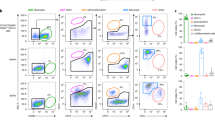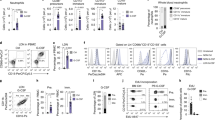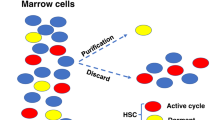Abstract
IN the presence of colony stimulating activity (CSA)1–5, both normal and neoplastic cells of the neutrophilic granulocyte (neutrophil) and monocyte–macrophage cell series proliferate and differentiate in semi-solid and liquid cultures6–9. However, as conventionally performed, the clonal assay for CSA depends on cellular proliferation, and does not provide quantitative information on the role of CSA in differentiation. Lactoferrin (LF) is a specific protein marker for the neutrophil cell series10–12, and among bone marrow cells is found exclusively in the specific granules of the maturing neutrophil13,14. These granules first appear at the myelocyte stage of cytodifferentiation15. Thus, synthesis of LF is a biochemical event which may be used to quantify a specific state of neutrophil differentiation. We previously reported the purification of murine LF16, and its quantification by radioimmunoassay17, and also the development of a slide chamber method for culturing bone marrow cells in liquid medium18. We now report that in similar cultures, the net synthesis of LF is correlated in a dose-dependent manner with CSA concentration. To our knowledge, this is the first demonstration of a quantitative relationship at both the biochemical and cellular levels between CSA and a specific marker of neutrophilic granulocyte differentiation19.
This is a preview of subscription content, access via your institution
Access options
Subscribe to this journal
Receive 51 print issues and online access
$199.00 per year
only $3.90 per issue
Buy this article
- Purchase on Springer Link
- Instant access to full article PDF
Prices may be subject to local taxes which are calculated during checkout
Similar content being viewed by others
References
Lajtha, L. G. & Schofield, R. Differentiation 2, 313–320 (1974).
Nienhuis, A. W. & Benz, E. J., Jr, N. Engl. J. Med. 297, 1318–1328; 1371–1381; 1430–1436 (1977).
Metcalf, D. Expl Hematol. 1, 185–201 (1973).
McCulloch, E. A., Mak, T. W., Price, G. B. & Till, J. E. Biochim. biophys. Acta 355, 260–299 (1974).
Stanley, E. R., Hansen, G., Woodcock, J. & Metcalf, D. Fedn Proc. 34, 2272–2278 (1975).
Pluznik, D. H. & Sachs, L. J. cell. Physiol. 66, 319–324 (1965).
Bradley, T. R. & Metcalf, D. Aust. J. exp. Biol. med. Sci. 44, 287–299 (1966).
Ichikawa, Y. J. cell. Physiol. 74, 223–234 (1969).
Cline, M. J. & Golde, D. W. Blood 47, 369–379 (1976).
Masson, P. L., Heremans, J. F. & Schonne, E. J. exp. Med. 130, 643–658 (1969).
Segars, F., Treadwell, P. E. & Kinkade, J. M. Jr, Proc. Am. Ass. Cancer Res. 16, 111 (1975).
Rausch, P. G., Pryzwansky, K. B. & Spitznagel, J. K. N. Engl. J. Med. 298, 693–698 (1978).
Baggiolini, M. deDuve, C. Masson, P. L. & Heremans, J. F. J. exp. Med. 131, 559–570 (1970).
Spitznagel, J. K. et al. Lab Invest. 30, 774–785 (1974).
Bainton, D., Br. J. Haemal. 29, 17–22 (1975).
Kinkade, J. M. Jr, Miller, W. W. K. III & Segars, F. M. Biochim. biophys. Acta 446, 407–418 (1976).
Segars, F. M. & Kinkade, J. M. Jr, J. Immun. Meth. 14, 1–14 (1977).
Winton, E. F., Vogler, W. R., Kellar, K. L., Parker, M. B. & Kinkade, J. M. Jr Blood 50, 289–302 (1977).
Kellar, K. L., Winton, E. F. & Kinkade, J. M. Jr, Blood 50 (Suppl. 1), 229 (1977).
Burgess, A. W., Camakaris, J. & Metcalf, D. J. biol. Chem. 252, 1998–2003 (1977).
Cooper, M. C., Levy, J., Cantor, L. N., Marks, P. A. & Rifkind, R. A. Proc. natn. Acad. Sci. U.S.A. 71, 1677–1680 (1974).
Fibach, E., Reuben, R. C., Rifkind, R. A. & Marks, P. A. Cancer Res. 37, 440–444 (1977).
Winton, E. F., Vogler, W. R., Kellar, K. L. & Kinkade, J. M. Jr Blood 50, (Suppl. 1), 271 (1977).
Price, G. B., Senn, J. S., McCulloch, E. A. & Till, J. E. Biochem. J. 148, 209–217 (1975).
Van den Engh, G. & Bol, S. Cell Tissue Kinet. 8, 579–587 (1975).
Metcalf, D. & MacDonald, H. R. J. cell. Physiol. 85, 643–654 (1975).
Stanley, E. R., Chen, D.-M. & Lin, H.-S. Nature 274, 168–178 (1978).
Author information
Authors and Affiliations
Rights and permissions
About this article
Cite this article
KINKADE, J., KELLAR, K. & WINTON, E. Immunochemical quantification of in vitro neutrophilic granulocyte differentiation. Nature 277, 225–227 (1979). https://doi.org/10.1038/277225a0
Received:
Accepted:
Issue Date:
DOI: https://doi.org/10.1038/277225a0
This article is cited by
-
Differential staining of neutrophils and monocytes: Surface and cytoplasmic iron-binding proteins
The Histochemical Journal (1988)
Comments
By submitting a comment you agree to abide by our Terms and Community Guidelines. If you find something abusive or that does not comply with our terms or guidelines please flag it as inappropriate.



